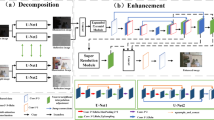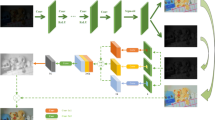Abstract
Aiming at the problems of color distortion, low image processing efficiency, rich context information, spatial information imbalance in the current low-light image enhancement algorithm based on a convolutional neural network. In this paper, an Attention-based multi-scale recursive residual network for low-light image enhancement (AMR-Net) is proposed based on high-resolution, single-scale image processing. First, shallow features are extracted using convolution and channel attention. In the recursive residual unit, a parallel multi-scale residual block is constructed, and the image features are extracted from the three scales: original image resolution, 1/2 resolution, and 1/4 resolution. Then, the deep features and shallow features are connected by selective kernel feature fusion to obtain rich context information and spatial information. Finally, the residual image is obtained by convolution processing of the deep features, and the enhanced image is obtained by adding the original image to the residual image. The experimental results on LOL, LIME, DICM, MEF datasets show that the proposed method has achieved good results in multiple indicators, and reasonably restored the brightness, contrast, and details of the image, thereby intuitively improving the perceived quality of the image.










Similar content being viewed by others
Data availability
Some or all data, models, or code generated or used during the study are available from the corresponding author by request.
References
Zhang, J., Kang, L.: Combined image enhancement for recyclable waste object detection in low-light environment. In: 2022 6th international symposium on computer science and intelligent control (ISCSIC), pp. 265–269 (2020)
Ye, L., Ma, Z.: LLOD: a object detection method under low-light condition by feature enhancement and fusion. In: 2023 4th international seminar on artificial intelligence, networking and information technology (AINIT), pp. 659–662 (2023)
Cho, S.W., Baek, N.R., Koo, J.H., et al.: Modified perceptual cycle generative adversarial network-based image enhancement for improving accuracy of low light image segmentation. IEEE Access 9, 6296–6324 (2020)
Mamiya, K., Miyata, T.: Few-class learning for image-classification-aware denoising. In: IEEE international conference on image processing (ICIP), pp. 948–952 (2020)
Lore, K.G., Akintayo, A., Sarkar, S.: LLNet: a deep autoencoder approach to natural low-light image enhancement. Pattern Recognit. 61, 650–662 (2017)
Lv, F., Lu, F., Wu, J., et al.: MBLLEN: low-light image/video enhancement using CNNs. BMVC. 220(1), 4 (2018)
Guo, C., Li, C., Guo, J., et al.: Zero-reference deep curve estimation for low-light image enhancement. In: Proceedings of the IEEE/CVF conference on computer vision and pattern recognition, pp. 1780–1789 (2020)
Lamba, M., Mitra, K.: Restoring extremely dark images in real time. In: Proceedings of the IEEE/CVF conference on computer vision and pattern recognition, pp. 3487–3497 (2021)
Jiang, Y., Gong, X., Liu, D., et al.: Enlightengan: deep light enhancement without paired supervision. IEEE Trans. Image Process. 30, 2340–2349 (2021)
Ren, J., et al.: Seeing through the noisy dark: toward real-world low-light image enhancement and denoising. arXiv:2210.00545. (2022)
Fan, C. M., Liu, T. J., Liu, K. H.: Half wavelet attention on M-Net+ for low-light image enhancement. In: IEEE international conference on image processing (ICIP). (2022)
Chen, C., Chen, Q., Xu, J., et al.: Learning to see in the dark. In: Proceedings of the IEEE conference on computer vision and pattern recognition, pp. 3291–3300 (2018)
Wang, L.W., Liu, Z.S., Siu, W.C., et al.: Lightening network for low-light image enhancement. IEEE Trans. Image Process. 29, 7984–7996 (2020)
Wang, M.M., Peng, D.L.: Retinex-ADNet: a low-light image enhancement system. J. Chin. Comput. 43(2), 367–371 (2022)
Zhang, Y., et al.: a fast and lightweight network for low-light image enhancement. arXiv:2304.02978 (2023)
Charbonnier, P., Blanc-Feraud, L., Aubert, G., et al.: Two deterministic half-quadratic regularization algorithms for computed imaging. In: Proceedings of 1st international conference on image processing, pp. 168–172 (1994)
Chu, X., Chen, L., Chen, C., et al.: Improving image restoration by revisiting global information aggregation. In: European conference on computer vision. Springer, Cham. pp. 53–71 (2022)
Waqas Zamir, S., Arora, A., Khan, S., et al.: Multi-stage progressive image restoration. arXiv:2102.02808. (2021)
Zamir, S.W., Arora, A., Khan, S., et al.: Restormer: Efficient transformer for high-resolution image restoration. In: Proceedings of the IEEE/CVF conference on computer vision and pattern recognition, pp. 5728–5739 (2022)
Li, X., Wang, W., Hu, X., et al.: Selective kernel networks. In: Proceedings of the IEEE/CVF conference on computer vision and pattern recognition, pp. 510–519 (2019)
Zamir, S.W., Arora, A., Khan., et al.: Learning enriched features for real image restoration and enhancement. In: Proceedings of the European conference on computer vision (ECCV), pp. 492–511 (2020)
Wei, C., Wang, W., Yang, W. et al.: Deep retinex decomposition for low-light enhancement. arXiv:1808.04560. (2018)
Guo, X., Li, Y., Ling, H.: LIME: low-light image enhancement via illumination map estimation. IEEE Trans. Image Process. 26(2), 982–993 (2016)
Lee, C., Lee, C., Kim, C.S.: Contrast enhancement based on layered difference representation of 2D histograms. IEEE Trans. Image Process. 22(12), 5372–5384 (2013)
Ma, K., Zeng, K., Wang, Z.: Perceptual quality assessment for multi-exposure image fusion. IEEE Trans. Process. 24(11), 3345–3356 (2015)
Zhang, Y., Zhang, J., Guo, X.: Kindling the darkness: A practical low-light image
Liu, R., Ma, L., Zhang, J., Fan, X., Luo, Z:. Retinex-inspired Unrolling with cooperative prior architecture search for low-light image enhancement. In: Conference on computer vision and pattern recognition, pp. 10556–10565 (2021)
Cui, Z., Li, K., Gu, L., et al.: You only need 90k parameters to adapt light: a light weight transformer for image enhancement and exposure correction. In: BMVC, pp. 21–24 (2022)
Fu, Z., Yang, Y., Tu, X., Huang, Y., Ding, X., Ma, K.-K.: Learning a simple low-light image enhancer from paired low-light instances. In: Proceedings of the IEEE/CVF conference on computer vision and pattern recognition, pp. 22252–22261 (2023)
Jie, H., Zuo, X., Gao, J., Liu, W., Hu, J., Cheng, S.: Llformer: An efficient and real-time lidar lane detection method based on transformer. In: Proceedings of the 2023 5th international conference on pattern recognition and intelligent systems, pp.18–23 (2023)
Funding
This work is supported by the National Natural Science Foundation of China Project No.62076199.
Author information
Authors and Affiliations
Contributions
All authors made substantial contributions to the concept, design, and revision of the paper. KW and YZ wrote the main manuscript text. KL, HL and BS repared figured and table.
Corresponding author
Ethics declarations
Conflict of interest
The authors have no competing interests that might be perceived to influence the results and/or discussion reported in this paper.
Additional information
Publisher's Note
Springer Nature remains neutral with regard to jurisdictional claims in published maps and institutional affiliations.
Rights and permissions
Springer Nature or its licensor (e.g. a society or other partner) holds exclusive rights to this article under a publishing agreement with the author(s) or other rightsholder(s); author self-archiving of the accepted manuscript version of this article is solely governed by the terms of such publishing agreement and applicable law.
About this article
Cite this article
Wang, K., Zheng, Y., Liao, K. et al. Attention-based multi-scale recursive residual network for low-light image enhancement. SIViP 18, 2521–2531 (2024). https://doi.org/10.1007/s11760-023-02927-y
Received:
Revised:
Accepted:
Published:
Issue Date:
DOI: https://doi.org/10.1007/s11760-023-02927-y




